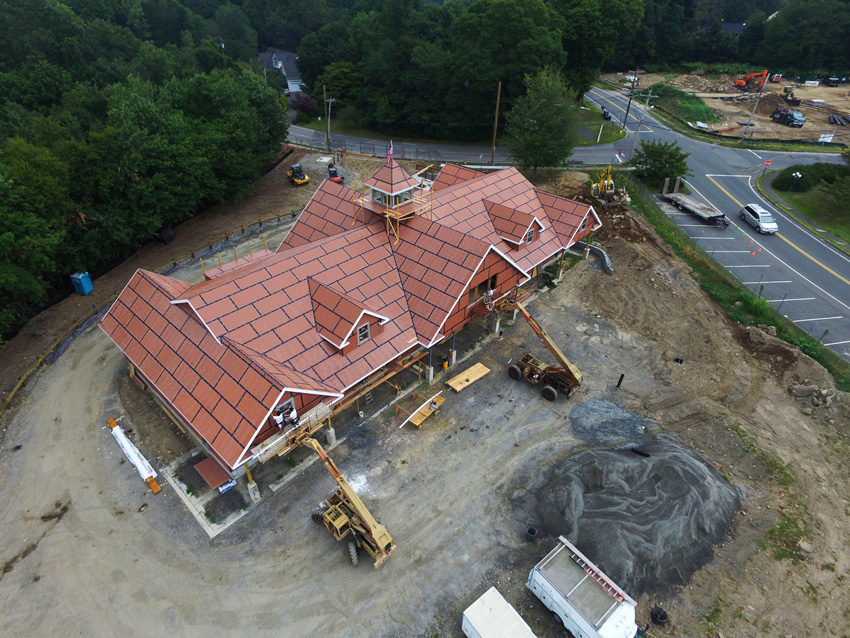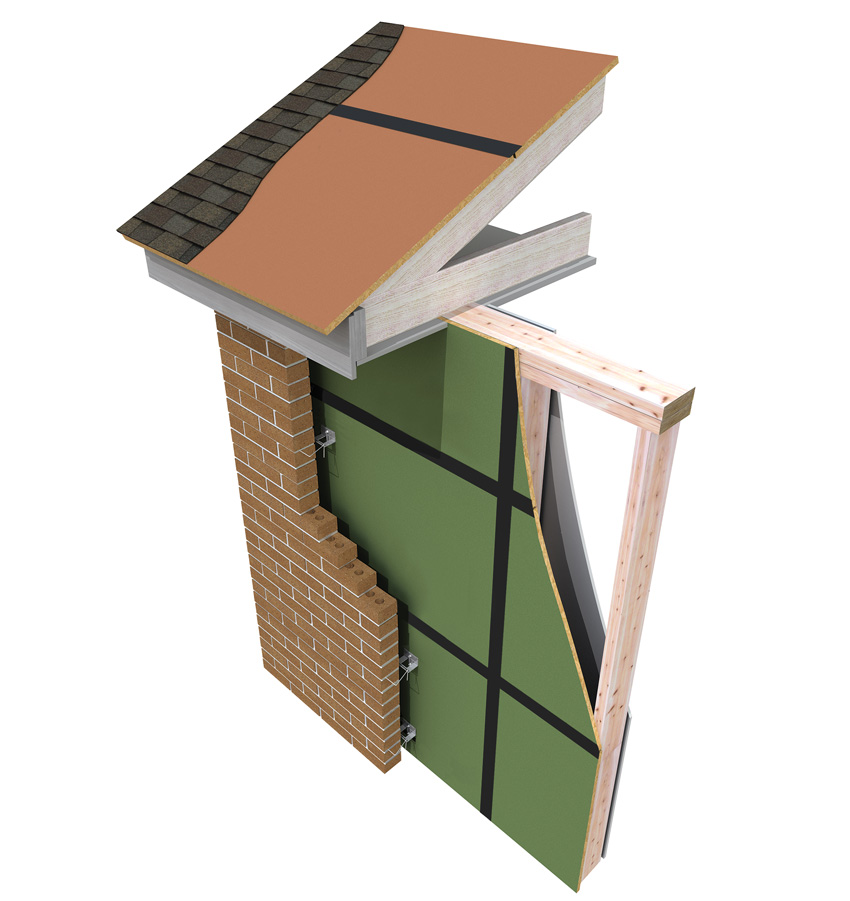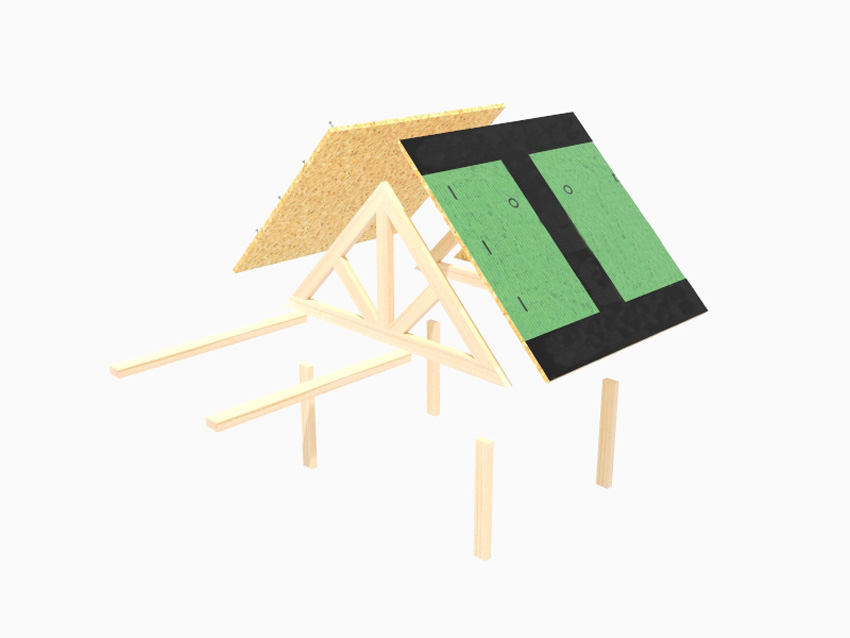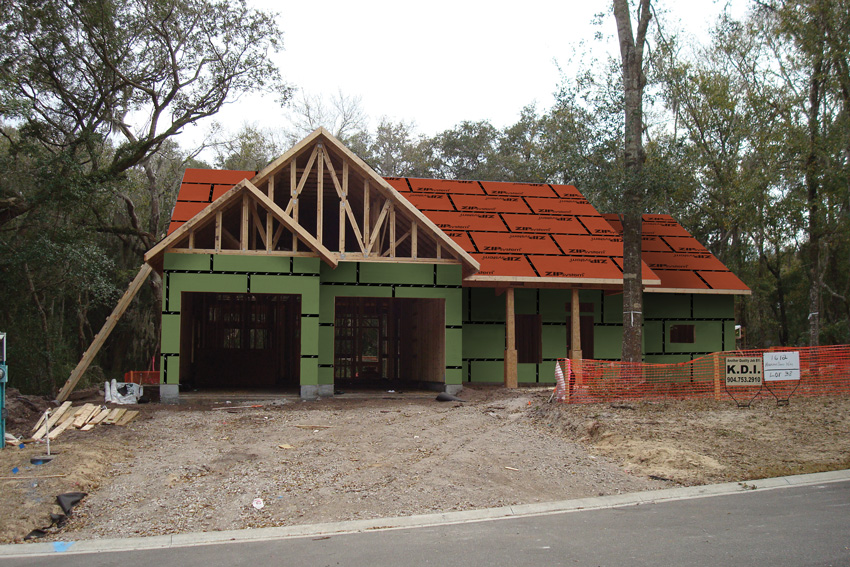High-Performing, Resilient, Wood-Framed Roofs
Anatomy of a Wood-Framed Roof
With an understanding of the forces and principles at work and some of the programs and standards that can influence design, let’s take a closer look at all of the components of a wood-framed roof. As we look at each, we can delve into the role they play individually and collectively toward achieving a high performing system that is resilient enough to withstand severe conditions.
Roof Pitch
The most fundamental, and usually most visible, aspect of a roof design is the pitch or slope of the roof surface. Commonly stated in terms of its vertical rise in inches over a horizontal run, typically of 12 inches, this has been the basis of wood-framed roof geometry for centuries. According to most industry protocols, the pitches for common roof types include:
• Flat Roof: Less than 2:12 (less than 17 percent)
• Low Slope: 2:12 through 4:12 (17 to 33 percent)
• Conventional Slope Roof: 4:12 through 9:12 (33 to 75 percent)
• Steep Slope: 9:12 and higher (75 percent and higher)

Photo courtesy of Huber Engineered Woods
Pitched roofs tend to be favored in wood-framed construction because they require little maintenance and have long service lives.
While the slope has an effect on the roof style and materials used as well as the space in the building’s interior, the primary purpose of sloping a roof is to shed water. Many roofing contractors maintain that conventional or steep-sloped roofs are generally more expensive in first costs than their lower-sloped counterparts because of the framing to create the slope. However, they also last longer, require much less maintenance, and withstand water better over time compared to flat or low-slope roofs. Since a sloped roof is essentially designed to drain water away, not contain it or seal it out completely as in a flat roof, the choice of materials are broader. On the other hand, flat roofs may be cheaper to build in terms of structure, but the single-ply membranes appropriate for use are limited in choice and usually a more costly material. Furthermore, over their service lives, flat roofs will likely require regular, ongoing maintenance and can be more prone to roof leaks. The biggest concern with flat roofs is the creation of “ponding” that can occur with a heavy rain or snowfall. The added weight can cause the sheathing or substrate to sag and allow water to collect or “pond” on the roof, and thus keep it from flowing to the roof drains. Or snow and ice could build up and similarly prevent the drainage of water. This standing water on the roof then adds unanticipated long-term weight and means that the roofing membrane needs to be fully watertight to avoid leaks—in effect acting like a swimming pool or bathtub liner. While some commercial buildings are able to successfully use flat and low-slope roofing, residential wood-framed buildings more typically rely on the shedding properties of sloped roofs.
Stick-Built Versus Truss Construction
Having determined the best roof slope for a particular building, the next consideration in a wood-framed system is the type of roof construction: stick built on-site or premanufactured roof trusses. Each system will rest on dimensional lumber or engineered wood that forms the wall structure below it, and each roof construction type has its own advantages and disadvantages.

Photo courtesy of Huber Engineered Woods/source: www.hometips.com
Stick-built wood framing for roofing structures relies on field-cut rafters to accommodate the proper roof slope, overhangs, and details.
• Stick-Built Roof Framing: A stick-built roof consists of individual rafters, each cut and secured by the builder to form the shape and pitch of the roofline. All roof members are typically cut and installed on-site. The rafters are sloped, attached to the top of the wall framing, and sit on an incline to create the roof pitch. Flexibility is the area in which stick-built roofs often have an advantage. Although trusses can be customized for many types of structures, they may fall short when it comes to complicated roof designs that incorporate specialty features, such as numerous dormers, hips, rolling hips, or turret roofs. Stick built also has an advantage in structures that must accommodate attics or cathedral ceilings, as roof trusses typically use the attic space for the structural makeup of the truss, not for living space, and can’t be modified without compromising their strength.

Photo courtesy of Huber Engineered Woods
Wood-truss construction for roof framing is generally regarded as more cost effective than stick built and capable of achieving customized solutions.
• Truss Construction: Roof trusses are commonly a triangular pre-engineered assembly made from 2-by-4 or other dimensional lumber that is cut and pressure nailed together. Multiple trusses, commonly spaced at 16 or 24 inches on center, are used to create the underlying frame of a roof. Trusses are usually engineered and manufactured off-site to exact specifications and can be mass produced efficiently, reducing costs, the size of the roofing crew, and delays from errors that can occur on stick-built roofs. Truss systems are custom engineered and fabricated for a specific job and cannot be altered on-site without re-engineering. Despite the fact that with stick-built construction all framing lumber can be purchased locally and delivered quickly, it is generally considered that a roof truss system is more economical. This has become so well accepted that in many areas, roof trusses have replaced traditional stick framing, saving labor and simplifying the roof-framing process. Further, using advanced computer modeling, truss fabricators can create designs incorporating required loadings and space-saving shapes with minimal waste.
Roof Sheathing
Serving as a structural skin that ties the rafters or trusses in place, roof sheathing supports the roof covering and transmits the load of this material as well as the live loads due to snow, ice, and wind back to the rafters or trusses. Once nailed in place, the sheathing becomes the base for fastening the roof coverings. In the early 20th century, most roof sheathing was made from cut wood planks. Today, roof sheathing is typically either manufactured plywood or oriented strand board (OSB).
• Plywood: Constructed out of glued layers of orthogonally stacked wood veneers hot pressed together, plywood is a structural panel resistant to contraction and expansion. While lighter than OSB, when exposed to water, plywood is susceptible to delaminating and weakening, which can cause the sheathing to lose strength and compromise the nailing. In a worst-case scenario over a prolonged period of time, the roof covering will have to be removed, and the sheathing replaced.
• Common OSB: In OSB, precisely cut wood strands are mixed with resin binders and oriented in a four-layer process in which two core layers are oriented perpendicular to two surface layers. The panel is then cured under intense heat and pressure to form a lasting bond between the strands. OSB sheathing is used extensively in residential and commercial construction as an alternative to plywood. Common OSB panels are typically heavier and less absorbent than plywood.

Photo courtesy of Huber Engineered Woods
Roof sheathing systems with a water-resistive barrier integrated onto high-performance structural engineered wood panels with taped panel seams eliminate the need for felt, while increasing a home’s resiliency.
• High-Performance OSB: Common OSB can be subject to edge swelling when exposed to moisture. However, high-performance OSB with greater water resistance is now readily available and commonplace. It is treated along the edges and surfaces to resist water, avoid edge swelling, and other rigors. High-performance OSB is considered a high-quality alternative to plywood and commodity OSB. It has been proven to be much more durable both during construction and severe weather events.
Underlayments
Initially used for temporary protection against the elements, roofing underlayment is now an integral part of an overall roof system. It provides and extra layer of protection on top of the sheathing, in addition to the final roof covering, to help keep out water and moisture. Underlayment is also required by building codes in the interest of maintaining the integrity of the roof system with provisions for such things as resistance to fire, wind-driven rain, wind uplift, and punctures. The proper selection of a particular underlayment material depends on a variety of factors in addition to the code, including roof slope, the finished roofing material used, and climate. For example, an underlayment material that performs well under a metal roof in the hot, humid South may not hold up in a cold Northeast climate under wooden shingles. It is important then to understand the capabilities and appropriate applications for the different types of underlayment and their ability to perform well.
There are typically four main categories of underlayments: felt, synthetics, self-adhering ice and water barriers, and wood structural panels with a built-in moisture-resistive barrier. Each is discussed in more detail as follows:









